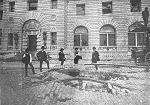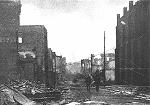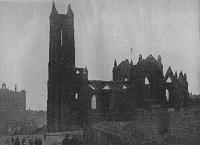 force. The earth heaved as if in labor. Massive buildings rocked upon their foundations, weak structures were wrenched and torn apart, others sunk partly into the ground, and others utterly con lapsed into heaps of wreckage.
force. The earth heaved as if in labor. Massive buildings rocked upon their foundations, weak structures were wrenched and torn apart, others sunk partly into the ground, and others utterly con lapsed into heaps of wreckage.When dawned that awful day The city lay in sleep Beside the placid bay, Whose waves in gentle sweep Came on the beach to play From out the glowing deep. |
Like houses built of cards The structures toppled down And heaps of stones and shards Beneath a smoking frown Is what the sun regards Where once was reared the town. |
On dome and wall the light Of morning brightly beamed, On towers lifting white The early sunlight gleamed, While nature touched with night In seeming safety dreamed. |
In terror from their sleep The people rouse and wake, And white with fear they creep Beneath the walls that shake, Too horrified to weep, Their hearts in wonder break. |
And then the earth began To tremble and to quake, The tremors quickly ran And walls began to shake, While all the works of man Like straw began to break. |
So dawned that awful day, But out of that despair There flashes forth a ray Of hope, divinely fair; The darkness fades away And visions fill the air. |
And all that man had wrought Through years of toll and pain Was in some power caught And leveled to a plain, And flames with fury fraught Began their fearful reign. |
From out this wreck will rise A city, strong and great, And under golden skies Will blot this ashen state, In which today it lies To greet a grander fate. |
| --Will Reed Dunroy. |
THE San Francisco earthquake horror and conflagration was the most colossal and appalling disaster that has ever befallen an American city.
When the first news of the catastrophe flashed across the continent that the beautiful metropolis of the Golden Gate had been shaken to its foundation by a seismic convulsion and was in flames that threatened its total destruction, it shocked and stunned the entire nation.
So closely are the American people knit together by bonds of brotherhood and mutual interests in all material affairs that the calamity which had befallen San Francisco and other coast cities at once became a national calamity. As such it will remain a national historic event for all time.
No other great city in America is so thoroughly isolated from its cosmopolitan sisters as San Francisco. Portland on the north, Los Angeles on the south and Salt Lake City on the east are her nearest great neighbors. By reason of this fact and the further one that the city is the great entrepot of commerce with the Orient, San Francisco was and again will be the mistress of the Pacific Coast.
Despite the fact that the Pacific Coast is annually visited by slight tremors of the earth, there was never before a fear of such a convulsion as the one just experienced, and so it was that on that fateful eighteenth of April there was no apprehension of the impending doom.
The morning dawned with no sign of the awful fate awaiting the city, and the populace slept in seeming peace and security.
The city lay bathed in the morning light like a jewel on the front of a golden tiara. On the west coast of the peninsula upon which San Francisco is located the waters of the Pacific softly splashed upon the shore; on the north the waters of the Golden Gate were placed, while on the east the beautiful bay of San Francisco presented an unruffled bosom to the morning light.
The populace slept. In the homes of artisans, clerks and laborers, members of the family were preparing the early morning meal, but the great mass of the pleasure-loving population were abed.
On every hand were the calm and quiet that betoken security. Suddenly the peace and silence were broken by a Titanic force. The earth heaved as if in labor. Massive buildings rocked upon their foundations, weak structures were wrenched and torn apart, others sunk partly into the ground, and others utterly con lapsed into heaps of wreckage.
force. The earth heaved as if in labor. Massive buildings rocked upon their foundations, weak structures were wrenched and torn apart, others sunk partly into the ground, and others utterly con lapsed into heaps of wreckage.
Great fissures yawned in the 'streets and at places the level earth was thrown up into mounds.
In the twinkling of an eye a scene of calm security was transformed into pandemonium. Amid the crash of buildings and falling walls and ceilings rose the shrieks of victims pinned in the ruins, and the never-to-be-forgotten cry of terror from thousands of lips that were white with fear.
Panic, such as rarely seizes upon men and women more than once in a lifetime, blind, unreasoning panic, reigned throughout the stricken city.
In the moments that followed immediately upon that awful convulsion of nature the terror-stricken people were guided but by one natural instinct--the first law of nature, self-preservation. Thousands of people Clad only in their night robes rushed madly into the streets, lit by the early light of day, seeking places of safety. Valuables were forgotten; the injured lay where they fell, beside the crushed and mangled bodies of less fortunate victims stark in death.
The great business thoroughfares were blocked and choked with the ruins of buildings that had once been San Francisco's pride. Many of them were landmarks of bonanza days with histories that would fill volumes if told in detail.
Such of the frantic people as were able to realize any part of the situation were conscious of the fact that San Francisco had experienced the most destructive earthquake in the history of the Pacific Coast.
Wreck and ruin lay everywhere in the business district and the bordering residence sections, and none knew what moment another upheaval might complete the work of destruction by annihilating the entire city.
Before the panic produced by the quake had time to subside, before reason regained supremacy over fear, a new peril--not more awful nor fear-inspiring, but more destructive, as it proved --confronted the people of San Francisco. Almost simultaneously with the earthquake shocks fires started in a dozen or more places, and a few moments later the business district of the city was in flames.
The magnitude of this new peril was not realized until the discovery was made that the earthquake had destroyed the water mains and there was no adequate means of combatting the flames which were spreading so rapidly that a general conflagration was threatened.
The people of the stricken city who had not fallen victims to the earthquake had escaped only to be numbered among the more numerous victims of the most destructive fire that had ever devastated an American city. And America was noted previously for two of the most ravaging conflagrations ever known--Chicago and Baltimore.
At the end of the first day's fire--Wednesday, April 18--practically the entire business district north and south of Market street, the city's principal artery of trade, was in ruins.
On the second day the old residence district known as the Mission, the famous Nob Hill district, where stood the mansions and palaces of the big bonanza kings of early railroad and mining days in California and Nevada, Chinatown, the Mecca of all tourists to San Francisco and one of the sights of the world, together with a wide residence area north, south and west, were destroyed by the fire, which still threatened to burn the entire city to the water's edge on three sides.
On the afternoon of the second day the flames had spread into the new millionaire residence district, of which Van Ness avenue, a beautiful boulevard ninety feet wide, is the principal thoroughfare.
On the third day, a part of Telegraph Hill, a less pretentious residence district, was destroyed, and only the most heroic efforts preserved the historic Fort Mason, established by General Winfield Scott on the eminence known as Black Point. The morning of the fourth day the flames were conquered, but not until they had destroyed a large number of docks and had threatened the destruction of the best known building in San Franciscty--the Ferry House--through which passes all of the passenger traffic to and from San Francisco.
For four days and three nights San Francisco was, metaphorically, in the very jaws of Hell. In that brief period of time the hearts of many men and women had grown as gray as the vista of ashes that marked the area of devastation.
The end had come, but what a terrible ending!
Death had been witnessed on every hand, but the dead were unnumbered. No historian present or future will ever be able to accurately call the death roll of the San Francisco Earthquake and Fire Horror. Many who perished in the quake were incinerated in the flames before any means of rescue were possible. Others were taken from ruins as charred and shapeless masses or mangled beyond recognition.
With respect to these fatalities, I quote the best possible authority, General Frederick Funston, who was practically in command of San Francisco at the time and to whom all sources of information' were open.

"The number of dead will never be known," said General Funston. "Block after block of roughly and cheaply built houses in the district south of Market street were leveled to the ground by the earthquake, and the loss of life, if not resulting from falling timbers, came with the sweep of the fire. The district was thickly populated with people whose names were hardly known by their neighbors in life, and whose names now never will be known."
The same difficulty was experienced in enumerating the injured. A great many who sustained injuries were fortunate enough to fall into the hands of friends and were cared for in private residences or taken from the city.
The story of every great disaster is replete with incidents of courage and heroism, and the San Francisco Earthquake and Fire Horror was no exception to the rule. The most important and interesting incidents of this character are narrated elsewhere in detail.
The courageous and heroic manner in which San Francisco as a community faced the appalling calamity and dealt with the situation was illustrated by the work of its Citizens' Committee, which administered all affairs relating to the relief and succor of the homeless and co-operated with the civil and military authorities in preserving Order and the forms of government during the perilous days of the conflagration.
It is to the everlasting glory of San Francisco and the credit of the United States troops at the Presidio and Fort Mason that the city was practically as free from lawlessness during its four (lays of peril as when in a normal conditions of affairs. It was Uncle Sam's "Boys in Blue" who brought order out of chaos and made life and property as safe while the fire raged as they were before and after. The several unfortunate and regrettable killings that took place were the work of citizens' patrol and youthful cadets.
Philosophers maintain that for every loss there is a compensation, and a beneficence for every misfortune.
In the case of San Francisco the compensation and beneficence ;are represented by the magnificent response the people of the entire nation made to the needs of the people in the stricken city. The catastrophe touched the heart strings of humanity and there was an outpouring of sympathy and money such as the world had never known.
The largest cities sent relief in millions, the smaller ones in thousands and hundreds of thousands. Every little town, hamlet, village and cross-roads engaged in a rivalry to send an amount worthy of their respective communities.
Relief trains bearing food, clothing, shelter-tents, medical supplies, physicians and nurses were on the way to the stricken city within a few hours from the time the magnitude of the disaster was realized.
The magnificent generosity of the American people in this instance, accompanied as it was on every hand by heartfelt expressions of sorrow and sympathy, not only proves the old aphorism that "one touch of nature makes the whole world kin," but it proves that the American people, despite their differences on a multiplicity of subjects, are at heart one people; that the United, States is one nation; that in times of stress we all stand shoulder to shoulder in a common brotherhood. It is a tribute, too, to the big, broad, whole-hearted way in which the American people rise- to a great occasion, promptly and adequately.
Stricken San Francisco!
Wracked by earthquake and scourged by flames.
A great commercial metropolis and city of beautiful homes reduced to a vast stretch of blackened ruins.
Such was the story of yesterday. Risen San Francisco!
A city beautiful and enduring, ribbed with steel and defying the elements.
Such is the story of to-day.
Twenty-five years ago the city of Chicago, then a smaller city than San Francisco before the great fire of April, was practically wiped off the map. Although the area devastated was much smaller than in San Francisco the property losses aggregated' $196,000,000. It was a city of wood, as was the destroyed city at the Golden Gate.
Out of that calamity has been evolved the modern steel buildlng--not necessarily a skyscraper, but a bird cage of steel, proof against any recurrence of disasters like the Chicago, Baltimore and San Francisco fires. Of such is the new San Francisco.
Aside from the destruction wrought by the San Francisco conflagration the loss of life and property in other Pacific Coast cities' from the earthquake are great and significant enough to fix the attention of the world upon the seismological disturbance that worked the destruction of the Golden Gate metropolis.
The heaviest losses outside of San Francisco were at San Jose, Santa Rosa, Palo Alto and Agnews. In the first two the largest and handsomest buildings were completely ruined and the loss of life ran into the hundreds.
At Palo Alto the chief claim to distinction is the Leland Stan- ford, Jr., University, one of the great educational institutions of the country. Here the entire group of the finest university buildings in America were practically demolished. Fortunately the great University--established by Senator Stanford--was later endowed by his widow, the late Jane Sanford, in the sum of $32,000,000, and hence there was no lack of funds for rebuilding.
The total collapse of the State Insane Asylum at Agnews, burying upward of a hundred insane patients in the ruins, was another evidence of the terrific force of the earthquake.
The rebuilding of San Francisco and the relief of the sufferers were matters within the scope of human achievement. The convulsion of nature that wrought such widespread havoc was beyond the power of man and beyond his ken.
Following so closely upon the eruption of the Vesuvius volcano and seismic disturbances in other parts of the world, the cause of the San Francisco earthquake furnished one of the interesting and important speculations of science. That feature of the San Francisco disaster I have endeavored to set forth fully by presenting the opinion of the leading seismologists and scientists of the world.
This in brief is a bare outline of the history of the greatest disaster of modern times--one that filled the world with horror and called forth universal sympathy. The facts of the disaster are faithfully recorded herein in detail and constitute a succession of the most thrilling experiences in the history of the world's great disasters.
RICHARD LINTHICUM.
Chicago, 1906.
